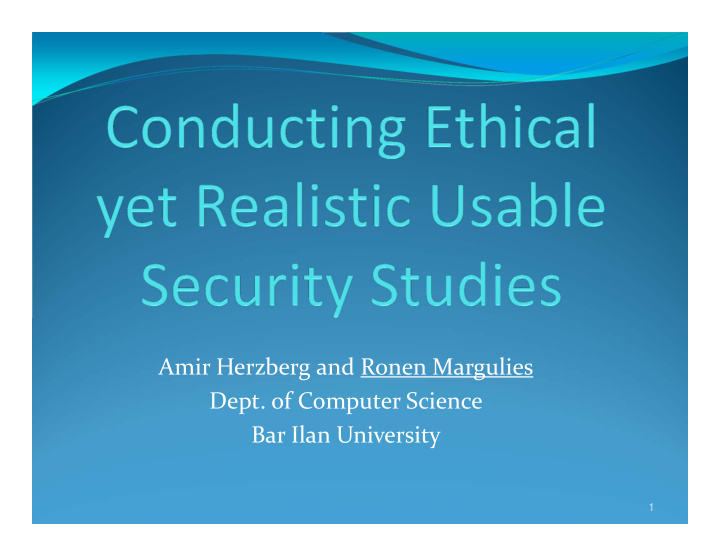



Amir Herzberg and Ronen Margulies Dept. of Computer Science Bar Ilan University 1
Agenda Conflicts in usable security studies Introducing the Experiment, or: “how to balance the risk level” Ethical Attacks Simulations 2
Conflicts in Usable Security Studies Two (conflicting) requirements for a user study Ethics : Users should know they might be attacked Realism : Users should act as in real ‐ life 3
What affects users’ behavior? Presenting the study’s (true) purpose Yes: users may be over cautious No: unethical(?), irrelevant for testing new defenses User account and risk : fake/real, site sensitivity Study’s environment Lab environment: @ University, w/ or w/o experimenter Home environment: personal device, favorite browser 4
Previous Anti ‐ Phishing User Studies Short ‐ term lab studies Unaware less Awareness to study’s purpose more cautious than real life cautious than real life Very low Rather high Low ‐ Medium detection detection detection rates, 0-8% rates, 63-95% rates 3-40% [WMG06, SD*07, [DTH06, WMG06, HJ08] [DTH06, WMG06, SD*07] HJ08] 5
Solution: Long ‐ Term Real ‐ Use Studies Long ‐ term experiment, real ‐ purpose system Realistic Awareness is not a problem (less focus on security) New mechanisms can be taught Familiar environment Ethical : users know they will be attacked What else is missing? Use of real sensitive user accounts is unacceptable Need to provide motivation to detect attacks as in sensitive sites 6
Agenda Conflicts in usable security studies Introducing the Experiment, or: “how to balance the risk level” Ethical Attacks Simulations 7
Balancing Attack Detection Motivation Our system : Online exercise submission system ~ 400 students, used regularly for 2 years Dozens – hundreds logins per user `Only’ an exercise submission system, not so sensitive.. Sensitive Site: negative results upon credentials theft Rare but significant Our study: positive reward for detecting attacks Certain but not so significant Challenge to fine ‐ tune the reward to best match real ‐ life motivation 8
Introducing the Study First year, attempt # 1 : Weak Motivation Did not mention the study, only “test for mechanisms” Up to 5 points bonus for detecting attacks 26 % did not cooperate Second year, attempt # 2 : Extra Motivation Explained about phishing, ourselves and the experiment Asked to participate and promised our gratitude 5 points bonus for participation, reduced if not detecting attacks 18 % did not cooperate 9
Fairness Reward is based on performance, performance is based on the defense mechanisms (some better than others) Is this fair? Is it Ethical? Division to groups of defense mechanisms is a must No harm done if not detecting attacks Compare with medical studies (weak medicine, placebo) 10
Agenda Conflicts in usable security studies Introducing the Experiment, or: “how to balance the risk level” Ethical Attacks Simulations 11
Ethical Attacks Simulations Deciding on simulated attacks Real ‐ life popularity & feasibility How hard it is to implement on a user ‐ study Legal & ethical issues, user ‐ consent Some attacks are problematic to simulate Pharming – requires DNS spoofing Browser interference (e.g., bookmark replacement) Partial implementation ( as if 1 st phase occurred) Redirect to spoofed site as if DNS poisoned Redirect to spoofed site as if bookmark replaced 12
Measuring Attacks Results What is the expected user behavior upon detecting a spoofed login page? How would users be sure their detection was noticed? Disconnecting is not enough, need to report detection We used a “Report Phishing Page” button Is there some bias here? Long ‐ term usage causes users to ignore the button unless feeling under attack 13
Conclusions Challenge # 1 : Realistic & Ethical studies Awareness + Long ‐ Term A solution to both issues Challenge # 2 : Sense of risk on non ‐ sensitive sites? Positive reward instead of using real sensitive accounts Challenge # 3 : Simulating Problematic Attacks Partial implementation of attacks as if 1 st phase occurred 14
Thank you! Questions? 15
Recommend
More recommend